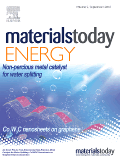
Materials Today Energy
Scope & Guideline
Driving Discoveries in the World of Energy Materials
Introduction
Aims and Scopes
- Energy Storage Materials:
Research on materials used for energy storage systems, including batteries (Li-ion, Na-ion, Zn-ion), supercapacitors, and solid-state batteries, focusing on enhancing performance, stability, and safety. - Photovoltaic Technologies:
Innovations in solar energy conversion, including the development of new materials for solar cells (organic, perovskite, and thin-film technologies) aimed at improving efficiency and stability. - Electrocatalysis and Fuel Cells:
Studies on catalysts for energy conversion processes, particularly in water splitting, CO2 reduction, and fuel cells, focusing on enhancing catalytic performance and reaction mechanisms. - Thermoelectric Materials:
Development of materials that can convert temperature differences into electrical energy, with a focus on improving thermoelectric efficiency and performance in various applications. - Sustainable and Green Technologies:
Research promoting the use of renewable resources and environmentally friendly materials, including waste-derived materials and biomimetic approaches for energy applications. - Nanostructured Materials:
Exploration of nanoscale materials and their unique properties to enhance performance in energy-related applications, including their synthesis, characterization, and integration into devices.
Trending and Emerging
- Advanced Solid-State Batteries:
There is an increasing emphasis on solid-state battery technologies, which promise higher energy densities and improved safety compared to traditional liquid electrolyte batteries. - Hybrid Energy Systems:
Research is trending towards hybrid systems that combine multiple energy storage technologies, such as integrating supercapacitors with batteries to enhance performance and efficiency. - Nanomaterials and 2D Materials:
Emerging interest in nanostructured materials, particularly two-dimensional materials like MXenes and graphene, for their unique properties and potential applications in energy storage and conversion. - Artificial Intelligence in Materials Research:
The application of AI and machine learning for materials discovery and optimization is gaining traction, enhancing the efficiency of research and development in energy materials. - Environmental Remediation Technologies:
Increased focus on materials and technologies aimed at environmental remediation, including CO2 capture and conversion, highlights the intersection of energy and environmental sustainability. - Bio-inspired Materials and Processes:
There is a growing trend towards the development of bio-inspired materials and processes, reflecting a shift towards sustainable and efficient energy solutions.
Declining or Waning
- Conventional Battery Technologies:
Research on traditional lithium-ion batteries is becoming less prominent as new materials and technologies for energy storage gain attention, such as sodium-ion and zinc-ion batteries. - Single-Use Materials:
The focus on single-use or non-recyclable materials is declining in favor of sustainable and recyclable materials, reflecting a broader trend towards environmental responsibility. - Basic Theoretical Studies:
There is a noticeable shift away from purely theoretical studies without immediate practical application, towards research that combines theoretical insights with experimental validation and real-world applications. - Rigid Solar Cell Designs:
Research on rigid and less flexible solar cell designs is waning, as there is a growing demand for flexible, lightweight, and portable solar energy solutions. - Electrolytes for Conventional Batteries:
The exploration of traditional liquid electrolytes is declining as more attention shifts towards solid-state and gel electrolytes that offer improved safety and performance.
Similar Journals
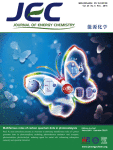
Journal of Energy Chemistry
Leading the Charge in Electrochemical InnovationThe Journal of Energy Chemistry, published by Elsevier, is a premier international journal that has established itself at the forefront of research in the fields of electrochemistry and energy technology. With an impressive impact factor, this journal is classified in the Q1 quartile across multiple categories including Energy Engineering and Power Technology, Fuel Technology, and Electrochemistry, underscoring its significant contribution to advancing knowledge and innovation in energy systems. Based in the Netherlands, the journal offers open access to its cutting-edge research, allowing for broad dissemination and engagement among researchers, professionals, and students alike. The scope of the journal spans crucial topics from chemical energy storage to sustainable energy solutions, making it an essential resource for those looking to understand and contribute to the evolving landscape of energy chemistry.
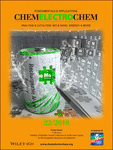
ChemElectroChem
Unlocking innovative solutions for a sustainable future.ChemElectroChem is a premier open-access journal published by WILEY-V C H VERLAG GMBH, focusing on the interdisciplinary fields of catalysis and electrochemistry. Established in 2014 and actively publishing until 2024, this journal boasts an impressive reputation, currently ranked in the Q2 category for both catalysis and electrochemistry according to the 2023 metrics. With an Scopus ranking placing it in the 74th percentile for Electrochemistry and 61st for Chemical Engineering and Catalysis, ChemElectroChem serves as an essential platform for researchers, professionals, and students dedicated to advancing knowledge and fostering innovation in these critical scientific domains. Since its transition to open access in 2023, the journal aims to maximize the dissemination of cutting-edge research and facilitate the exchange of ideas among global scholars, thereby enhancing the accessibility and impact of high-quality science within the community. For those engaged in the ever-evolving conversations around energy storage, conversion processes, and sustainable solutions, ChemElectroChem is an invaluable resource.

eScience
Empowering Discoveries in Electrochemistry and BeyondeScience, published by KEAI PUBLISHING LTD, is an innovative open-access journal that has rapidly established itself as a leading platform in the fields of Electrochemistry, Materials Chemistry, and Renewable Energy, Sustainability, and the Environment. Since its inception in 2021, eScience has garnered recognition for its high-quality research, achieving an impressive Q1 ranking in each of its primary categories as of 2023. With a remarkable Scopus ranking—placing it among the top percentile of journals in these disciplines—eScience serves as an essential resource for researchers and practitioners aiming to advance knowledge and application in sustainable practices and materials innovation. As an open-access journal, eScience supports widespread dissemination of vital research, ensuring accessibility for all, which is critical in addressing contemporary global challenges. The journal's commitment to fostering interdisciplinary dialogue and collaboration positions it as a cornerstone for those dedicated to pushing the boundaries of scientific discovery.

Journal of Power Sources Advances
Unleashing Potential in Energy Engineering and Materials ChemistryJournal of Power Sources Advances, published by ELSEVIER, stands at the forefront of innovative research within the fields of Electrochemistry, Energy Engineering and Power Technology, and Materials Chemistry. Having established itself as an Open Access journal since 2020, it aims to disseminate knowledge rapidly and widely among researchers, professionals, and students interested in the latest advancements in power sources technology. With an impressive impact factor and recognition as a Q1 journal in 2023 across multiple categories, it addresses key challenges and innovations in energy generation, storage, and materials development. The journal's commitment to high-quality, peer-reviewed content fosters a vibrant community for discussing breakthroughs that hold the potential to transform energy systems globally. The journal operates out of the Netherlands, enhancing its global outreach, while its strong Scopus rankings highlight its influential role in driving research within its scope. Journal of Power Sources Advances is the pivotal resource for those dedicated to shaping the future of energy sustainability and technology.
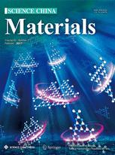
Science China-Materials
Unveiling Breakthroughs in Material Development.Science China-Materials is an esteemed peer-reviewed journal dedicated to advancing the field of materials science, published by SCIENCE PRESS. With a strong focus on innovative research and applications, this journal provides an essential platform for disseminating groundbreaking findings in materials development, characterization, and engineering. Since its inception, Science China-Materials has achieved an impressive Q1 ranking in the Materials Science (miscellaneous) category, reflecting its commitment to quality and the impact of its publications, as indicated by its 86th percentile ranking in Scopus. The journal is set to converge its contributions from 2016 to 2024, making it a vital resource for researchers and professionals interested in the latest advancements and trends in materials science. As an open access publication, it ensures that knowledge is freely available to a global audience, promoting collaboration and innovation across disciplines. The journal is headquartered in Beijing, China, and continues to attract high-quality submissions from leading experts in the field.
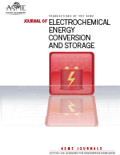
Journal of Electrochemical Energy Conversion and Storage
Advancing the Future of Energy SolutionsThe Journal of Electrochemical Energy Conversion and Storage, published by ASME, is a premier platform for cutting-edge research in the fields of electrochemistry, energy engineering, and materials science. With an ISSN of 2381-6872 and an E-ISSN of 2381-6910, this journal aims to disseminate high-quality articles that contribute to the understanding and application of energy conversion and storage technologies. Notably recognized in the 2023 Category Quartiles as Q2 in multiple categories including Electronic, Optical and Magnetic Materials, Energy Engineering and Power Technology, and Mechanical Engineering, it reflects a strong academic impact within its field. The journal also boasts competitive Scopus rankings, highlighting its relevance and influence across disciplines. Operating under an open access model, the journal ensures that research findings are widely accessible, fostering collaboration and innovation among researchers, professionals, and students globally. As we move toward a more sustainable future, the Journal of Electrochemical Energy Conversion and Storage plays a critical role in advancing technologies that promise to reshape how we harness and utilize energy.
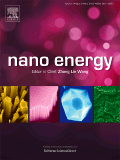
Nano Energy
Exploring the Future of Energy at the NanoscaleNano Energy is a premier journal published by Elsevier, focused on the dynamic intersection of nano-technology and energy solutions. Since its inception in 2012, this high-impact journal has made significant strides in advancing research across multiple disciplines, showcasing groundbreaking studies in Electrical and Electronic Engineering, Materials Science, and Renewable Energy. With an impressive Impact Factor that places it in the Q1 category of these fields—including a distinguished rank of #6 in Electrical Engineering and #9 in Renewable Energy on Scopus—the journal serves as a vital resource for academics and practitioners alike. Nano Energy aims to disseminate innovative research and developments that contribute to the sustainable energy landscape, thereby addressing pressing global energy challenges. Researchers and professionals seeking to stay at the forefront of nanotechnology applications in energy generation and efficiency will find this journal an indispensable platform for sharing knowledge and driving impact.
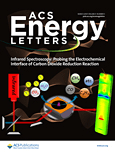
ACS Energy Letters
Advancing Energy Innovation for a Sustainable FutureACS Energy Letters, published by the American Chemical Society, is a prestigious peer-reviewed journal designed to disseminate innovative and impactful research in the multifaceted field of energy science. Since its inception in 2016, the journal has quickly ascended to a remarkable status, achieving Q1 rankings in critical categories including Chemistry (miscellaneous), Energy Engineering and Power Technology, Fuel Technology, Materials Chemistry, and Renewable Energy, Sustainability and the Environment as of 2023. With an emphasis on rigorous research methodologies and interdisciplinary collaboration, ACS Energy Letters serves as a vital platform for scholars, professionals, and students to explore cutting-edge research that addresses contemporary energy challenges. While maintaining a commitment to advancing knowledge without open access, it offers profound insights into sustainable practices and innovative solutions that are crucial for the future of energy systems globally. The journal's esteemed standing in the chemical and energy sectors underscores its significance, making it an essential resource for anyone invested in the advancement of energy technologies and sustainable practices.

RUSSIAN JOURNAL OF ELECTROCHEMISTRY
Exploring the Frontiers of Electrochemical ScienceThe Russian Journal of Electrochemistry, published by Pleiades Publishing Inc, is a reputable scientific resource that caters to the dynamic field of electrochemistry. Since its inception in 1996, this journal has become a platform for the dissemination of cutting-edge research, exploring both foundational studies and innovative applications within electrochemical science. Despite currently holding a Q4 categorization in its field, the journal is dedicated to enhancing its scholarly impact and visibility, reflecting its commitment to fostering advancements in electrochemical technologies. With its ISSN 1023-1935 and E-ISSN 1608-3342, the journal strives to reach a global audience of researchers, professionals, and students alike. Though the journal is not open access, its contents are crucial for anyone looking to stay at the forefront of electrochemical research and developments. The journal's editorial board includes well-respected experts, ensuring that published articles contribute significantly to the scientific community and pave the way for future innovations in the field.

EnergyChem
Leading Research for Tomorrow's Energy Challenges.EnergyChem is a premier academic journal published by ELSEVIER, dedicated to advancing the field of energy chemistry and its applications in sustainable technologies. With a strong focus on biomaterials and innovative chemistry solutions, the journal has established itself as a leading platform within the research community, boasting remarkable rankings such as Q1 in Biomaterials, Chemistry (miscellaneous), and Energy (miscellaneous) for 2023. Notably, it ranks 2nd in both Materials Science and Energy categories, reflecting the high caliber of research it publishes, which is crucial for tackling pressing global energy challenges. Since its inception in 2019, EnergyChem has been committed to open and accessible research, making it an invaluable resource for researchers, professionals, and students striving for cutting-edge insights in energy conversion and storage. With its target audience in mind, the journal encourages submissions that explore innovative materials, processes, and applications that will contribute to a sustainable energy future.